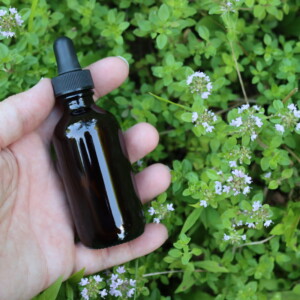
Thyme Tincture
A thyme tincture is a homemade herbal remedy for coughs and other respiratory complaints, and it's easy to make with just a few common pantry ingredients.
Equipment
Ingredients
- Thyme dried or fresh
- Neutral Spirit such as vodka*
Instructions
- Begin by filling a clean mason jar about halfway with dried thyme. If using fresh thyme, pack the jar loosely to allow space for the herbs to expand as they infuse. Fresh thyme will require a bit more room than dried, so keep this in mind when filling the jar.
- Pour your chosen alcohol over the thyme until the plant material is completely submerged. Vodka is the most commonly used alcohol for tinctures because it has a neutral flavor, but you can also use brandy, rum, or any other high-proof alcohol (at least 60 proof). The alcohol helps extract the beneficial compounds from the thyme, so it’s important that the herbs are fully covered.
- Once the jar is filled, seal it with a tight-fitting lid and shake gently to mix the alcohol and thyme. Store the jar in a cool, dark place for about 6 to 8 weeks. A cupboard or dark shelf is ideal.
- Every few days, give the jar a gentle shake to help with the extraction process. During this time, check that the thyme remains fully submerged in the alcohol—if any plant material floats above the liquid, add a bit more alcohol to cover it.
- After 6 to 8 weeks, strain the tincture through a cheesecloth or fine mesh strainer into a clean dark glass bottle. Use a funnel to guide the liquid into the bottle and press on the thyme to extract all of the liquid. Discard the thyme once the tincture is fully strained.
- Label the bottle with the name of the herb, the date it was made, and any dosage instructions. Store the tincture in a cool, dark place, away from sunlight, for long-term preservation.
Notes
*Vodka is often the best choice because it has little to no flavor and doesn’t interfere with the natural taste of thyme. However, you can use other spirits like rum or brandy for a more unique flavor profile.
Never use denatured or isopropyl alcohol, as these are toxic and unsafe for human consumption.
Expected Yield
The amount of tincture you get will depend on whether you're using fresh or dried thyme. Fresh herbs will release more liquid into the tincture, while dried thyme may absorb some of the alcohol, resulting in a slightly lower yield. For a quart jar, you will typically need around 2 to 3 cups of alcohol, or 1 to 1.5 cups if you're using a pint-sized jar. Be sure to check the alcohol level regularly and top it off if needed to keep the thyme submerged.Glycerite Tincture (Alcohol-Free Option)
If you'd like to avoid alcohol, you can make a glycerite tincture. For this method, cover the dried thyme with a mixture of 3 parts vegetable glycerin and 1 part distilled water. If using fresh thyme, you can omit the water and use just glycerin. As with the alcohol tincture, shake the glycerite every day to aid in the extraction, and proceed with the same steps once the infusion is complete. Tried this recipe?Let us know how it was!